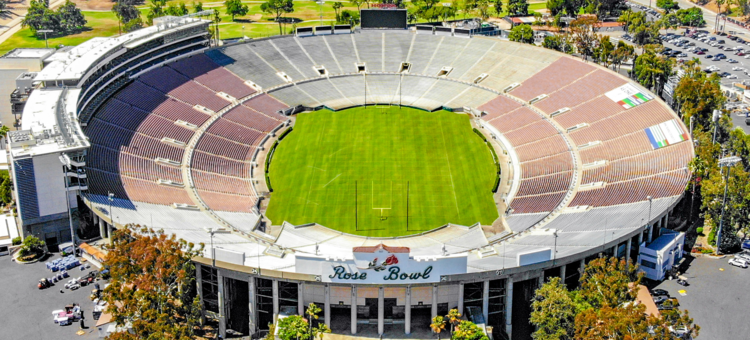As a kid growing up in Los Angeles during the 1950s, nothing was more exciting to me than the January 1st Rose Bowl.
Back then, Los Angeles had no Dodgers, no Lakers, no Kings, and no Clippers. The city had the professional football Rams—an explosive team led first by quarterbacks Bob Waterfield (married to movie starlet Jane Russell) and then the taciturn "Dutchman", Norm Van Brocklin.
And the town—believe it or not Los Angeles was a small town in those days—had two beloved minor league baseball teams, the Los Angeles Angels and the Hollywood Stars.
But the Rose Bowl, as a once a year event, was Southern California's sporting ne plus ultra. And for people who couldn't get into football, the Pasadena Tournament of Roses Parade was as thrilling as the game itself.
From my early childhood until 1956, the year my family left Los Angeles, we started each New Year's Day by watching the parade on our tiny black and white television set.
And that family tradition carried on no matter where we lived.
Over the course of the decades, one famous Grand Marshall after another led the annual parade. Many were Hollywood icons: Bob Hope (twice), Frank Sinatra, Jimmy Stewart, Gregory Peck, Danny Kaye, Loren Green, Shirley Temple Black, Lawrence Welk, Angela Lansbury, Carol Burnett, John Wayne and Roy Rogers and Dale Evans.
Others were athletes: Hank Aaron, Merlin Olsen, Pele, "Chi Chi" Rodriguez, Carl Lewis, and Arnold Palmer.
Even politicians got into the act: Herbert Hoover, Senator Everett Dirksen, Senator John Glenn, Richard Nixon (twice), Gerald Ford and Dwight Eisenhower.
Once the parade ended, our focus shifted to the game, fondly referred to as "The Granddaddy of Them All"—meaning the biggest and the best of the bowls. With the Rose Bowl attendance averaging 102,000, no other game generated more interest.
From its inception in 1947 through 2001, the Rose Bowl was played between the winners of the Pac-10 conference (earlier the Pac-8) and the Big Ten.
Fans automatically—and correctly as it invariably turned out—anticipated that the midwestern visitors would trounce the Pac-10 team. From 1947 thorough 1959, the Big Ten won 12 of the 13 games.
As Californians focused on the Rose Bowl, we had only a vague awareness that football had been played that day in other parts of the country.
The final scores from the Sugar Bowl, the Orange Bowl and the Cotton Bowl were all in before the Rose Bowl kicked off.
Incredible as it seems today, college football had only four bowl games. All were played on January 1st.
I don't have to tell you how much else has changed.
- The Rose Parade's elaborate floats—once constructed by volunteers and using as many fresh flowers as the average florist sells over five years—now depend on high-tech computerized animation and exotic natural materials from around the world. Professionals who specialize in float construction build most of the entries.
- The 2006 parade will be held on Monday, January 2nd; but the Rose Bowl will be played on Wednesday, January 4th.
- Established in 1998 the Bowl Championship Series, the BCS, opened up the Rose Bowl to teams from other conferences. Since 2002, the Miami Hurricanes, the Oklahoma Sooners, the Nebraska Cornhuskers and the Texas Longhorns have played in Pasadena.
Thankfully, one thing—the most important thing—has not changed. The Rose Bowl players, the Trojans' Matt Leinert and Reggie Bush and the Longhorns' Vince Young, are among the most outstanding in the nation and will go down among college football's all-time best.
In 1982, then-Tournament of Roses President Harold E. Coombes created the Rose Bowl Hall of Fame to honor outstanding individuals who have contributed to the Rose Bowl's success. Eligible for induction are players, coaches, school administrators, athletic directors and conference officials.
Among those already in the Rose Bowl Hall of Fame are Stanford's Jim Plunkett, Ernie Nevers, Frank Albert and John Ralston; Southern California's Charles White, O.J. Simpson, Pat Haden and Pete Beathard; Illinois' Buddy Young and Dick Butkus and Ohio State's Archie Griffin and W.W. "Woody" Hayes.
Regardless of the outcome of the Trojan-Longhorn showdown, you can be sure that Leinart, Bush and Young will be added to the long list of great players already in the Rose Bowl Hall of Fame.
Joe Guzzardi [email him], an instructor in English at the Lodi Adult School, has been writing a weekly column since 1988. It currently appears in the Lodi News-Sentinel.













